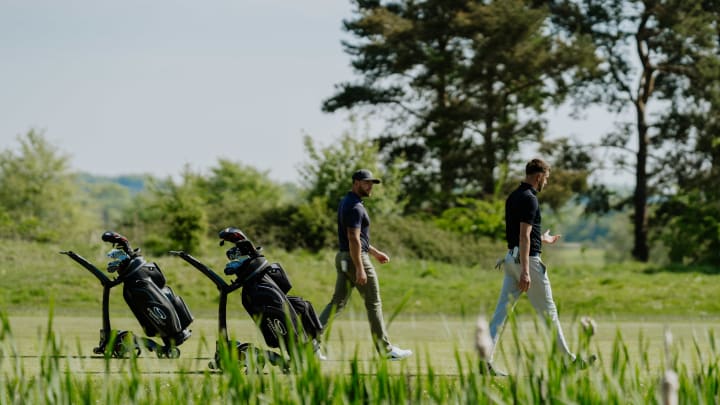On Tiger Woods, Southern Hills and the Luxury of Walking

I’m not a golf snob. Riding in a golf cart is fine by me. When I reflect on the countless cart rounds spent with my grandpa Dan or my dad or my wife or with dozens of architects, entertainers and a smattering of tour pros who have shared a cart with me, I think of the laughs, celebrations, curses and stories swapped.
I continue to marvel that at least once a week somebody puffs out their chest on social media and rails against cart use in golf. “Cartball is an abomination” is the usual smack talk. Spare me.
Golf cars, as they’re more properly known, have been a staple in the sport since the 1950s. At many courses they’re mandatory. In multiple over-55 age restricted communities, they’ve replaced the actual automobile as the preferred means of transport to the club and to the grocery store. For many golfers, they’re a necessity. My smack talk: “Let ‘em ride!”
That preamble notwithstanding, I prefer to walk. Even in the days when I was toting around a dangerous number of extra pounds, when given a choice, I chose to hoof it. There were, alas, occasions where it wasn’t prudent for me to do so, given the heat or hills. Yet, as I scan the list of the world’s top 15 courses, I realize I’ve walked them all. Walking added immensely to the pleasure of the journey.
A Phoenix outing in late March with representatives from British-based Stewart Golf rekindled my appreciation for golf on foot. They asked me to take a test spin with a new product, the Q Follow, an updated version of an existing model of a motorized trolley, or what Stewart calls an "electric caddie." I was skeptical. Why would I opt for this mode of club transport when a regular, human-powered trolley worked just fine? And why would someone pay upwards of $1,000 plus for such a vehicle? I soon discovered why.
Prior to venturing to the first tee, we had a practice session. Understand that I’m a technophobe, who wouldn’t know the difference between a Bluetooth and a wisdom tooth. It took all of two minutes to learn how to operate the handset. More verbal instructions gave me the confidence to know when to manually steer the trolley (seldom, but occasionally necessary), when to switch to “Remote,” when you prefer to see what’s going on with your bag and then, most satisfying of all, when to press the “Follow” button.
This was the most fun and liberating, when the trolley follows you around, wherever you walk. Yes, it was like having a caddie, though without the helpful reads and wisecracks. I had to switch back to “Remote” with some of the more awkward turns or abrupt slopes at the Raven Golf Club, but that wasn’t difficult to do. I was also pleasantly surprised at how compact, yet stable it was in maneuvering amid occasionally challenging terrain. I’ve lost count as to how many times my old-fashioned trolley has tipped over on links all over Great Britain and Ireland. I was converted.
I’m not on Stewart Golf’s payroll. One day I might own a Q Follow electric golf trolley or I might not. They do have competitors, too. Still, I like what the UK publication Today’s Golfer wrote about the Q Follow: “Stewart Golf’s electric trolleys are very much like Bentleys — they’re made in Britain with high-quality materials, you don’t see them at every turn and new models only come to market after years of hard work and innovation.”
What my experience with the electric trolley revealed, however, was a renewed appreciation for the joys of walking a golf course. It sparked something within, something I vowed to do more of. On many courses, some of us simply aren’t fit or athletic enough to toss a carry bag over our shoulder and go. And so many American courses, private and public, still harbor a stubborn view that trolleys are for munis only.
Yet, the appeal of walking a golf course is so strong. Between the rhythm attained, the swing thought processes accommodated, the natural and man-made course design features to take in at your own pace — and yes, the exercise — it’s undeniably the better form of golf. And it wasn’t until Woods stopped off at Southern Hills on April 28 that I stopped taking the act of walking a golf course for granted.
As we now know, after his car crash in February 2021, Woods wasn’t sure he’d have two legs to walk on again. Somehow — because he’s Tiger Woods — he sufficiently recovered and rehabbed to be able to play through the pain and walk 72 holes at Augusta National during the 2022 Masters.
Later that month, he flew to Tulsa for a reconnaissance mission with Southern Hills, where he won the 2007 PGA Championship. He toured all 18 holes as a test run to determine whether he could and should compete in the upcoming PGA. Apparently, he passed the test. But what a dilemma. Dispensations have been issued in the past, even in major championships, for those who couldn’t play without the use of motorized transportation. Woods, though, has maintained that if he is unable to walk the course, he isn’t going to compete in the championship.
I contemplated what kind of walking test Southern Hills would yield for Woods — and the field. At the 2001 U.S. Open, I thought I might expire walking up the massive hill that fronted the ninth and 18th greens. It was mid-June, after all, and I was in no shape for mountain climbing. I played Southern Hills in May 2014, in the company of three architects, during the annual meeting of the American Society of Golf Course Architects. My companions were all reasonably fit, but also all north of 50 years old. We rode.
What I recall, however, is that despite its fortress-like green complexes to close out each nine, the undulations at Southern Hills weren’t fearful. There’s contour in the fairways and uphill shots into the greens at the par-4 4th and par-4 10th, but the elevations are modest. I figure that if Woods survived the descent down the hill off the first tee, he would be just fine.
Woods' plight got me musing. Even while in obvious discomfort, he is relishing his return to major championship golf. In his comments, you hear his gratitude for merely being able to walk again, let alone compete. In comparing walking versus riding, I still look at both as playing golf. Thinking about Woods, however, pushed me across at least one line. I was never going to take walking a golf course for granted again.
